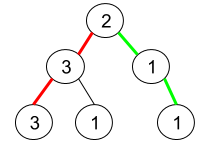LeetCode 1457. Pseudo-Palindromic Paths in a Binary Tree
2020-05-24 21:30:09
# leetcode
Problem
LeetCode 1457. Pseudo-Palindromic Paths in a Binary Tree
1. 题目简述
给你一棵二叉树,每个节点的值为 1 到 9 。我们称二叉树中的一条路径是 「伪回文」的,当它满足:路径经过的所有节点值的排列中,存在一个回文序列。
返回从根到叶子节点的所有路径中“伪回文”路径的数目。例如:
Input: root = [2,3,1,3,1,null,1]
Output: 2
Explanation: 上图为给定的二叉树。总共有 3 条从根到叶子的路径:红色路径 [2,3,3] ,绿色路径 [2,1,1] 和路径 [2,3,1] 。
在这些路径中,只有红色和绿色的路径是伪回文路径,因为红色路径 [2,3,3] 存在回文排列 [3,2,3] ,绿色路径 [2,1,1] 存在回文排列 [1,2,1] 。
2. 算法思路
奇偶性
需要计算每条从root到根节点路径中每种数字的奇偶性,然后到达根节点时判断个数为奇数的数字是否最多只有一个。如果是,则res++;否则直接返回。
奇偶性 + bit manipulation
其实我们并不需要知道每种数字的具体个数,只要知道奇偶性即可。因此我们用一个10位bit来记录,如果为奇数,则bit位为1,偶数则bit位为0。最终判断bit位为1的个数。
3. 解法(LeetCode 105 & 106)
- 奇偶性
使用Arrays.copyOfRange(int[] data, int start, int end)函数,写起来简洁,但是有点慢,而且耗空间大,因为要截取数组。
1 |
|
- 奇偶性 + bit manipulation,注意二进制里1个数的计算。另外,java不支持默认参数,所以需要另写一个辅助函数。
1 |
|
